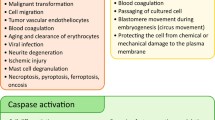Abstract
The induction phase of programmed cell death (PCD) or apoptosis is characterized by an extreme heterogeneity of potential PCD-triggering signal transduction pathways. During the subsequent effector phase, the numerous PCD-inducing stimuli converge into a few stereotypical pathways and cells pass a 'point of no return', thus becoming irreversibly committed to death. Evidence is accumulating that cytoplasmic structures, including mitochondria, participate in the critical effector stage and that alterations usually considered to define apoptosis, as nuclear chromatolysis and cytolysis, have to be ascribed to the late degradation phase. We and others have recently shown that nuclear features of apoptosis are preceded by alterations in mitochondrial function and structure. The importance of these alterations for the apoptotic process and also the possible link between, these observations, the permeability transition pore and the programmed cell death, are dicussed. (Mol Cell Biochem 174: 185–188, 1997)
Similar content being viewed by others
References
Kroemer G, Petit PX, Zamzami N, Vaxssiere J-L, Mignotte B: The biochemistry of apoptosis, FASEB J 9: 1277–1287, 1995
Kerr JFR, Wyllie AH, Currie AR: Apoptosis: a basic biological phenomenon with wide-ranging implications in tissue kinetics. Br J Cancer 26: 239–257, 1972
Jacobson MD, Burne JF, Raff MC: Programmed cell death and Bc1-2 protection in the absence of a nucleus. EMBO J 13: 1899–1910, 1994
Schulze Osthoff K, Walczak H, Droge W, Krammer PH: Cell nucleus and DNA fragmentation are not required for apoptosis. J Cell Biol 127: 15–20, 1994
Zamzami N, Marchetti P, Castedo M, Zanin C, Vayssière J-L, Petit PX, Kroemer G: Reduction in mitochondrial potential constitutes an early irreversible step of programmed lymphocyte death in vivo. J Exp Med 181: 1661–1672, 1995
Zoratti M, Szabò I: The mitochondrial permeability transition. Biochem Biophys Acta 1241: 139–176, 1995
Zamzami N, Marchetti P, Castedo M, Decaudin D, Macho A, Hirsch T, Susin SA, Petit PX, Mignotte B, Kroemer G: Sequential reduction of mitochondrial transmembrane potential and generation of reactive oxygen species in early programmed cell death. J Exp Med 182: 367– 377, 1995
Gunter TE, Pfeiffer DR: Mechanismus by which mitochondria transport calcium. Am J Physiol 258: C755–C786, 1990
Bernardi P, Broekemeier KM, Pfeiffer DR: Recent progress on regulation of the mitochondrial permeability transition pore; a cyclosporinsensitive pore in the inner mitochondrial membrane. J Bioenerg Biomem 26: 509–517, 1994
Castedo M, Macho A, Zamzami N, Hirsch T, Marchetti P, Uriel J, Kroemer G: Mitochondrial perturbations define lymphocytes undergoing apoptotic depletion in vivo. Eur J Immunol 25: 3277–3284, 1995
Zamzami N, Susin SA, Marchetti P., Hirsch T, Gómez-Monterrey I, Castedo M, Kroemer G: Mitochondrial control of nuclear apoptosis. J Exp Med 183: 1533– 1544, 1996
Macho A, Decaudin D, Castedo M, Hirsch T, Susin SAS, Zamzami N, Kromer G.: Chloromethyl-X-rosamine-An aldehyde-fixable potential-sensitive fluorochrome for the detection of early apoptosis. Cytometry in press: 1996
Deckwerth TL, Johnson EM: Temporal analysis of events associated with programmed cell death (apoptosis) of sympathetic neurons deprived of nerve growth factor. J Cell Biol 123: 1207–1222, 1993
Rawadi G, Roman-Roman S, Castedo M, Dutilleul V, Susin S, Marchetti P, Kroemer G: Effects of Mycoplasma fermentans on the myelomonocytic lineage. Different molecular entities with cytokineinducing and cytocidal properties. J Immunol 156: 670–678, 1996
Sato N, Iwata S, Nakamura K, Hori T, Mori K, Yodoi J: Thiol-mediated redox regulation of apoptosis. Possible roles of cellular thiols other than glutathione in T cell apoptosis. J Immunol 154: 3194–3203, 1995
Marchetti P, Hirsch T, Zamzami N, Castedo M, Decaudin D, Susin SA, Masse B, Kroemer G: Mitochondrial permeability transition triggers lymphocyte apoptosis. J Biol Chem submitted: 1996
Author information
Authors and Affiliations
Rights and permissions
About this article
Cite this article
Petit, P.X., Zamzami, N., Vayssière, JL. et al. Implication of mitochondria in apoptosis. Mol Cell Biochem 174, 185–188 (1997). https://doi.org/10.1023/A:1006848205880
Issue Date:
DOI: https://doi.org/10.1023/A:1006848205880




